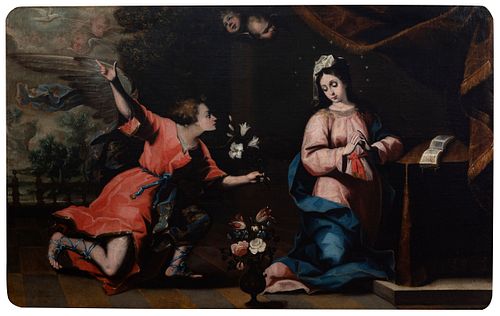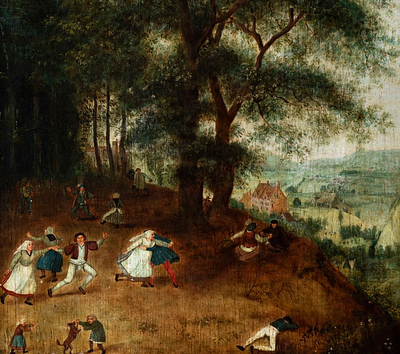Circle of JUAN LUIS ZAMBRANO (Córdoba, 1598 - 1639). "Annunciation". Oil on canvas. Relined.
Lot 56
About Seller
Setdart Auction House
Carrer Aragó 346
Barcelona
Spain
Setdart Subastas was born in 2004 and is currently the first online art auction in Spain with solidity, prestige and reliability guaranteed by our more than 60,000 users. Setdart has a young, dynamic and enterprising team ready to successfully manage the purchase and sale of art works through custom...Read more
Estimate:
EUR€10,000 - EUR€12,000
$10,752.69 - $12,903.23
Absentee vs Live bid
Two ways to bid:
- Leave a max absentee bid and the platform will bid on your behalf up to your maximum bid during the live auction.
- Bid live during the auction and your bids will be submitted real-time to the auctioneer.
Bid Increments
| Price | Bid Increment |
|---|---|
| EUR€0 | EUR€10 |
| EUR€200 | EUR€25 |
| EUR€500 | EUR€50 |
| EUR€1,000 | EUR€100 |
| EUR€3,000 | EUR€200 |
| EUR€5,000 | EUR€500 |
| EUR€10,000 | EUR€1,000 |
| EUR€20,000 | EUR€2,000 |
| EUR€50,000 | EUR€5,000 |
About Auction
By Setdart Auction House
Jun 30, 2021
Set Reminder
2021-06-30 08:30:00
2021-06-30 08:30:00
America/New_York
Bidsquare
Bidsquare : Old Masters
https://www.bidsquare.com/auctions/setdart-auction-house/old-masters-7134
Setdart Auction House sofia@setdart.com
Setdart Auction House sofia@setdart.com
- Lot Description
Circle of JUAN LUIS ZAMBRANO (Córdoba, 1598 - 1639). "Annunciation". Oil on canvas. Relined. Measurements: 103 x 161 cm; 122 x 186 cm (frame). This canvas depicts the episode of the Annunciation, with a composition of long tradition that organizes the space symmetrically, with the figures of Mary and the archangel Gabriel facing each other, in half profile, and the Holy Spirit in the form of a dove on top. The scene is set in a dark interior setting, typical of Spanish naturalistic baroque, immersed in an expressive and nuanced half-light, against which the figures stand out, vividly illuminated. The classical compositional rigor acquires dynamism through the zigzagging rhythm, dynamic and distinctly baroque, which begins at Mary's head, passes through the face and hand of the angel and culminates in the upper Gloria break, where the Holy Spirit appears. The Annunciation is one of the most represented themes in Christian art for marking the Incarnation of Christ as man and as God, while Mary maintains her purity and virginal state, points of great theological importance. Thus, throughout the evolution of the different styles in European art, there is a great variety of models and different details according to style, school and period. The present work is related to Baroque works because of the palette chosen, the iconography (with details maintained from previous traditions), the light contrasts, etc., and it is especially inscribed in the circle of Juan Luis Zambrano. It is known that Zambrano was born in Cordoba in 1598, since on February 13 of that year he was baptized in the parish church of El Sagrario and that his parents were Álvaro Sánchez and Juana Gómez. Of the painter's childhood hardly anything is known, and less of his formation and apprenticeship; Palomino, Ceán Bermúdez, González de Guevara make him a disciple of Pablo de Céspedes, an opinion that today is not accepted, since when the illustrious racionero died, in 1608, Zambrano was barely ten years old, which makes us discard a direct relationship of apprenticeship. It is more admissible to suspect that, when Céspedes died and the city lacked great masters, he went to Seville, in search of new channels and wider possibilities than those offered in his native city, and that there he came into contact with the most prestigious artists who at that time -first decades of the 17th century-, stood out in the field of painting, such as Francisco Pacheco, Juan de las Roelas, Francisco de Herrera El Viejo. It is precisely the traces that can be seen in Zambrano's work - coming from the style of both Roelas and Herrera - that lead us to affirm the reality of certain contacts established with the Sevillian School, without being able to specify whether they were direct or through the knowledge of his pictorial productions. Whatever the case may be, it seems admissible to think that Juan Luis Zambrano, eager to learn new things, and attracted by the fame and splendor of the city of Seville, went to this city as Mohedano had done and later Antonio del Castillo would do. It is impossible to specify what relationship the painter had with Seville or what years of his youth he spent there; what is known today is that he died in this city and is even attributed with a production that was previously considered Zurbaránesque.
- Shipping Info
-
In-house shipping available. Please inquire at admin@setdart.com.
-
- Buyer's Premium



 EUR
EUR CAD
CAD AUD
AUD GBP
GBP MXN
MXN HKD
HKD CNY
CNY MYR
MYR SEK
SEK SGD
SGD CHF
CHF THB
THB

















